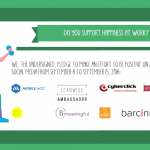We know the answers, but are we asking ourselves the right questions? Verne Harish starts off yesterday’s Growth Summit 2013 by posing three basic questions to assure your company keeps on growing and evolves into a breakthrough business:
1) What is the single story your entire company can focus on?
2) How will you get the crowd to help you to reach your goals?
3) Do you have the right people doing the right things right?
On the foot of Mt. Tibidabo in Barcelona, business people from Spain, UK, Germany, Slovakia, Netherlands and Switzerland gathered in the beautiful premises of the IESE business school. They attended a day of lectures to strengthen their decision making capacity and get to know the challenges of being a leader. The speakers involved the audience by letting them think on a problem, stimulate interaction by discussing a situation with their neighbors, and asking a lot of questions. Furthermore, they used the method of giving a statement and providing an example from a company who did it. Show, don’t tell.
Back to business. How can you excel in this century? Whoever gets the most people on board to support their products (ratings, likes, updates etc.), wins. Therefore, the objective of business in the 21st century is a race to get the most brains engaged. Social media is disrupting the way we do business, but also the investment sector. For example, competitions like the Goldcorp Challenge engage the whole world in solving their challenges with only the top three winning a prize. The question is whether this approach will be sustainable in the long-term and whether it is ethical to let so many people work on a challenge and only pay the winners. Of course, it is one’s own decision to enroll in the competition, and now with the crises and lack of other alternatives, people are willing to make that bet. But be aware, betting can be addictive. You must be very clear on the criteria you use to evaluate and engage in events like these. Nonetheless, it shows that alternative ways for funding and crowdsourcing are becoming increasingly diverse and ambiguous.
So, how can you compete in this era of robotics, big data and the fast-growing BRIC countries? By doubling the revenue per employee in 5-10 years and putting your people at the center of your business. A business on its own is nothing, the most precious asset are the people within it. Help them grow and business growth will follow. Be ready with new challenges for your employees and make them strive to grow into the best version of themselves.
Take advantage of the big data trend. Data is more and more affordable for all. People can add data, share it, use various sets and create new stuff out of it…and all online. Additionally, you can use the available data for market research, predictions and positioning your firm (e.g. sizeup.com and BIgml.com). But to do so, you must be very clear in your business model and your focus. Stick to the essence of having a business that is teachable, valuable and repeatable. Be aware of your revenue model. Both John Mullins and John Warrillow pay attention to this vital part of a business and propose different alternatives of how you might tackle this in your business; from subscription-based models to maximizing your gross margin. Have I already mentioned Steve Jobs? Well, you know the stories. On this day he popped up multiple times.
When thinking of starting a new business, ask yourselves which element you could alter in business. What’s the analog you might copy to do so? Get inspired by reverse innovation; you need to be sourcing new business models and analogs from growth countries. If you don’t know what is happening out there, you will be left behind.
The final message of the day: After the 25th birthday, companies grow explosive. Look at Apple and Starbucks. If you are not so long in town, you still have time to grow, but be aware of the different growth phases (see Margaret). If your business is older than 25 year, perhaps you should refocus.
Below more in depth parts of the speeches per speaker
Top decisions in business history by Verne Harnish
The greatest business decisions of all time provide us with insight on the mindset that made companies grow. Learn from them.
His top 5:
1) Ford. One of the first companies that saw people as an investment. Ford was instrumental in making USA one of the world’s wealthiest country.
2) Apple. Bringing back the entrepreneur Steve Jobs after 10 years being absent. Jobs’ knew that multi-tasking and large teams often results in disconnected and scattered work. Therefore, Steve created small teams with each focusing on only one project at a time. But remember, it wasn’t only Steve Jobs behind Apple’s success. He had great people behind him helping him revolutionize this brand.
3) Wal Mart. The leading principle in this company is “What did you learn/hear when talking to customers, employers, suppliers this week that could improve our business?” Lesson: If you can make your company 1% better every week, compound interest is your friend.
4) Samsung. Motto: learn the language and the local culture. Samsung sent employees to different countries for a 3 month stay, tasked with investigating the different cultures in each location. By the end of their research, they had to deliver an 80 page report on the country. This was the basis to become a worldwide top brand. Lesson: Get out of town and participate in the global economy.
5) GE. Keep on moving forth is the only way. Hence, all employers must be challenged. For this purpose, GE invested in executive education.
Verne’s reading suggestion for coming month: Jim Collins. A book on how you can get great by choice through Return on Luck (ROL). What do you do to turn bad luck into opportunities? And how do you react to the good luck?
Building Breakthrough Business Models: John Mullins
Question: Why most startups don’t reach the exit and plan A usually isn’t realized ? Because the business model doesn’t work. Too little money comes in and too much is spent. John gives five building blocks to alter your business model and make it work:
1) What’s your revenue model?
People mostly earn more on plan B than on plan A. Princess Maritime Yacht was originally going into the fishing industry, but their boats were so beautiful and popular that people started to buy the boats before they could even start the fishing business. The takeaway? Most companies don’t stick to their original business model.
2) Your gross margin model?
Zynga makes sure the customer gets hooked on your product, so when addicted customers want to buy additions. And the good thing for Zynga, ones developed and no further costs are attached, but the additions will be bought over and over again.
3) Your operating model?
RyanAir transforming to a low cost airline by taking out the parts that aren’t necessary. For a good example on this business model innovation, have a look at Henry Chesbrough’s presentation on Open Innovation (slide 13-15).
4) Your working capital model?
Costco wholesale (warehouse to buy in bulk) offers quality low prices in high quantity – good prices from vendors and lower prices for customers, but customers must be a member for the privilege to buy in their shop. The membership fee is where they get there revenue, and also have the money upfront. Another addition: no credit cards, only cash and debit. The result? Costco always has enough cash flow, especially since their vendors are paid up to 60 days after delivery.
5) Your investment model?
Skype needed hardly any infrastructure, hence small investment to make VoIP working. They made the service free and as a result had 7 million users in one year. Later on they started to offer additions, on which they started to receive money.
Try this exercise: Which one element could alter in your business? What’s the analog you might copy to do so?
Key Advice to Remember:
1) Don’t fall in love with your own product, look for analogs! What’s out there in the market? What does the community like and willing to pay for? Also, what doesn’t work and what are their problems and shortcomings? Quoting Steve Jobs: ‘Picasso had a saying: he said good artist copy, great artists steal.’
2) Find a leap of faith to get you on a new and faster growth trajectory. What is the big problem that should be solved? Generate hypotheses to test it.
3) Make sure not to build your growth roadmap on naïve and unfounded assumptions. Work with real data from real customers on real products. Don’t write in your business plan: ‘we believe that ..’ Make sure that you have the data to prove and monitor the assumptions. Get real feedback.
Game of Warren Buffet presented by the gifted story teller Conor Neil presented the following situation:
– Invest €1000 in one person
– You will receive 10% of this persons income the rest of your life
Who would you bet on?
And a lesson on how to set the criteria to base your decision upon:
1) Integrity: Say no to most things (if you say yes all the time, you will be tracked away from your own values and believes or spread your attention on to many items).
Tool: make sure your agenda matches your aim of live. How you live your life demonstrates your values.
2) Energy: Vitality (young and vivid; keep moving) and biased towards action (act rather than thinking about acting)
Tool: Rest properly. Starting the day slowly. Before the rush of the day, have some time to think (listen to yourself) about how you are doing, what you have dreamed and answer to yourself at the end of the day ‘what do I want to be proud on’.
3) Adaptive intelligence: Flexibility to change when needed, have the ability to get the right data, ask more questions than answers. Tool: write things down, document and accumulate. What was interesting/ important/ what struck you that day.
Margaret Heffernan explained how business is just another human being.
Business is just people, not a machine. Companies go exactly through the same life stages as people do. A startup is like a baby. It needs endless attention and love and needs to be fed. The parent should think about the values and what it would like the baby to become. The puberty comes in when the company gets customers. It grows very fast, in an out of control manner. It needs some rules. It makes mistakes, but learns from them (hopefully). It also acknowledges that plans change, perhaps from A to B. If the company still survives and isn’t exploded, it will mature into adult. It can become hard to grow and hard to be interesting, and everybody may start to write you off. But you are not dead yet. So, how do you reinvent yourself? The challenge of growth is the challenge of innovation. Companies don’t have ideas, only humans can come up with the question: ‘ Wouldn’t it be great if…?’ Explore.
At the same time, Margaret warns us ‘the human brain is not designed to do multitasking!’ The brain will switch tasks, continuously, which is not an effective procedure. You will miss things and make mistakes. Margaret propagates a 40 hour work week, because that is the limit time in which our brain to be effective. And nowadays, working is mostly about thinking. Another take away, have great listening skills. Be aware not to be surrounded only with the same type of people . Watch out for too charismatic and authority leadership, because people will follow the leaders’ thoughts and not bring in his or her own ideas. If you look after the people, the people will look after the business. Don’t be a genius, be a genius maker. Nurture your employees, know them personally, develop them and put them on the growth path, and your business will follow.
Built to Sell by John Warrillow
You want to be part of a valuable company. They are a lot more fun to work for, because they have the funds to make development and growth happen. But it is important that the business is sustainable in being valuable and not too attached to one leader. See what is happening with Apple. John investigated that owners with companies that could survive their absence are 50% more likely to get an offer. So how can you make your business less dependent on you? The audience suggests to delegate: host a meeting but don’t show up, move away, have someone else the spokesperson, set clear objectives in which everyone can participate, send an update email on what will happen this week, have a supporting process in place. According to John, it comes down to teachable, valuable and repeatable products or services. Teachable has to do with the process and a clear objective. Value is differentiating from profit by figuring out how to sell less stuff to more people (customer diversification) instead of more stuff. And lastly, repeatable has to do with scalability.
Having these basic assets, it comes down to the reliability of the company. This is based on two pillars: reoccurring revenue and net promoter scores.
The Top 6 Recurring Revenue Models:
1) Long-term contracts: iPhone. If you use contracts in your business, make sure that they include a survivor clause. In the case the company changes owners , the obligations of the contract stay in touch for the new owner.
2) Auto Renewal Subscription: Iron Mountain. People are not aware of the renewal. If you ask, they might re-think, but when automatic, 95% stays a customer.
3) Sink money subscriptions: Bloomberg terminal. Have the hardware, but subscribe also for software update and services. Besides investing money, it might also be time. Invested time (training etc.) makes sticky to a product or service as well. The customer speaks your language and your platform is their basis.
4) Subscription: Magazine. It creates a positive working capital model because you charge upfront. Memberships work the same.
5) Sink money consumables: Nespresso . Ones hooked/opt into the platform (hardware), the customer is more likely to buy additions. In the case of Nespresso, having the machine the customer can only buy the capsules in their community and shops.
6) Consumables: Coffee. What runs out, so customers come back?
Calculating your Net Promoter Score
You can do this by having the promoters percentage and deduct the detractors percentage. What is left, is your NPS. This percentage tells how well known you are. To compare, Amazon has a score of 82%, Google 60%, and average is 20%. The calculating goes as follows:
% of Promoters 25%; liking, rebuying, referring and suggest your product (score 9-10)
% of Passives 70%: happy with the product, but not repurchasing( score 6-8)
% of Detractors 5%: unhappy and make bad promotion ( score < 5)








Leave a Reply